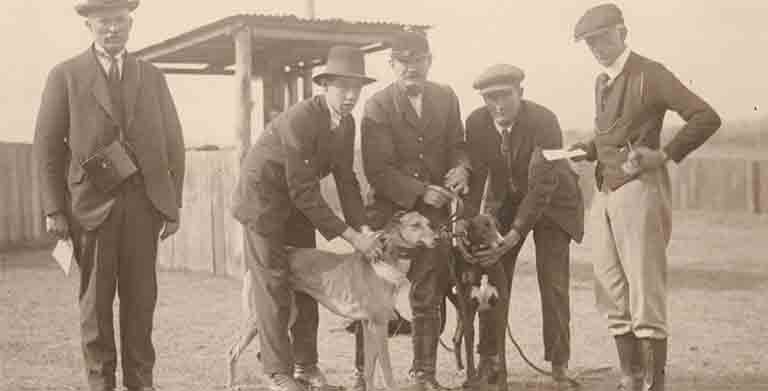The early struggle for a viable greyhound industry

Although the first greyhound race meeting behind a mechanical lure had taken place at night, on May 28, 1927, and the response from attendees was generally positive, the reality was that the new sport was doomed to failure if legalised betting could not take place.
The government of Premier Jack Lang had banned gambling on greyhound racing and the directors of the Greyhound Coursing Association (GCA), who introduced the sport into Australia, decided to conduct their second race meeting during the day.
The second meeting conducted at the Epping course (later better known as Harold Park) in Glebe, took place on the afternoon of June 6. Unfortunately, only a small crowd attended. An even smaller crowd attended the third meeting, held on a Sunday, June 11.
It was then fate played its hand. Premier Jack Lang's ministry, which was hardly a united band, was reshuffled. A brace of new parliamentarians were raised to ministerial positions, including Andrew Lysaght, appointed as the new Attorney-General. Known as ‘Ironbark Andy', Lysaght reviewed the plight of the greyhound industry and gave an opinion that its operations came within the meaning of the Gaming and Betting Act.
So, on Saturday afternoon June 18, the first legalised betting race meeting was held at Epping. Not surprisingly, a large crowd turned out, estimated at around 16,000 people, all paying admission. Considering Sydney's population at the time was around 1.2 million people, this was the equivalent of a crowd of 65,000 attending a similar race meeting in Sydney in 2017.
Despite this success, greyhound racing faced fierce opposition from vested interests, especially from those in control of thoroughbred racing and cinemas.
Yet the first test of its legality came from a member of the public. Alfred Miles, described as a master hatter, from Ashfield, submitted a statement at the Glebe police station in August 1927 claiming bookmaker Charles Gilbert had accepted a bet on what Mills claimed was an unlicensed racecourse, namely Epping, on ‘the coursing of dogs after a tin hare' on July 23. Miles suggested this was contrary to the provisions of the Gaming and Betting Act, passed in 1912.
The case went to court on September 8. In cross-examination Miles admitted he had been paid a fee, plus expenses, to attend the Epping meeting on July 23 and place bets with the accused bookmaker. Miles claimed a friend had arranged for him to attend the greyhound meeting and place the bets and the friend had stated, “We want to have a test case.”
When Miles was asked what he meant by “We”, he replied he didn't know. He denied any knowledge of knowing who might have been behind the prosecution, stating he knew nothing about coursing and had no interest in any sport except horse racing.
The magistrate's decision was handed down before a packed court on September 15. In a blow to the fledgling sport, the bookmaker Charles Gilbert was fined the minimum of £20 ($40). Part of the success of the argument against mechanical hare racing was that it was a ‘departure from the real thing', that is, field coursing. The prosecution suggested it would be like having mechanical bowling in cricket.
Gilbert applied for a writ of prohibition and the matter went before Mr Justice Campbell on October 4. Justice Campbell found ‘that the meaning to be attached to coursing, within Section 7 of the Gaming and Betting Act (1912), was not stereotyped, but was subject to natural evolution; and that there was no fundamental difference… between enclosed coursing and mechanical racing…'
That decision, by a judge rather than a magistrate, reaffirmed the legality of betting on greyhound racing. It also led to a rapid expansion of the sport across New South Wales.
Despite this legal victory, greyhound racing faced a further challenge when the Nationalist Party, led by Thomas Bavin, won the state election on October 18.
In an attempt to stop the expansion of greyhound racing, the new government banned night greyhound racing and night harness racing.
Despite being forced to race in the afternoons, the sport continued to flourish, much to the chagrin of the government and the churches.
In December 1927 the Anglican bishops of New South Wales addressed an open letter to Thomas Bavin in which they attacked gambling in general but greyhound racing in particular, stating, ‘We are convinced that license for betting on mechanical hare racing is calculated to extend the range, and increase the appetite for betting, especially among women and children. The State is threatened thereby with a most serious social peril.' Just why greyhound racing especially would entice women and children over adult males was not explained.
Despite the attacks made against it by a variety of both vested interests (horse racing, cinemas and even some people involved in enclosed coursing) and well-intentioned organisations such as the churches, supported by parts of the news media, greyhound racing with legalised gambling flourished, just as it had in the United Kingdom and parts of the United States.
The fight was far from over, but by the end of 1927 greyhound racing behind a mechanical lure had gained enormous traction across NSW.